![]()
![]()
![]()
Use LEFT and RIGHT arrow keys to navigate between flashcards;
Use UP and DOWN arrow keys to flip the card;
H to show hint;
A reads text to speech;
75 Cards in this Set
- Front
- Back
|
Describe the general sequence of the cell cycle. |
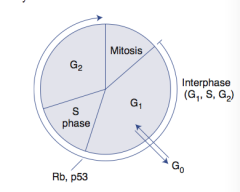
After mitosis, the cell cycle enters the G1 phase (growth phase 1). At this point, non proliferating cells enter G0 (quiescent phase), whereas active cells proceed to the synthesis phase (DNA replication). After S phase, G2 will occur for a short period before the cell divides again. |
|
|
Describe the G1 Checkpoint. |
end of G1 phase Most eukaryotic cells decide whether to proceed with DNA replication (S phase) or become quiescent (G0); depends on availability of nutrients, DNA damage and surrounding conditions.
Checkpoint largely dependent on p53 (determines if cell can go to S phase or G0) |
|
|
What are pathologies associated with G1 Checkpoint defects? |
Tumor suppressor genes:
p53-- chromosome 17p = Li-Fraumeni syndrome
Rb--chromosome 13q = retinoblastoma and osteosarcoma |
|
|
Describe the G2 Checkpoint. |
end of G2, just before mitosis
Two crucial molecules involved: Maturation promoting factor (MPF) Cyclindependent kinase (CDK) |
|
|
Describe the M Checkpoint. |
takes place in anaphase
action of CDK-1 triggers the destruction of cyclins, causing the cell to exit mitosis and enter cytokinesis |
|
|
Regulation of Cell Cycle: CDKs (cyclin dependent kinases) |
constitutive and inactive
A Cdks is an enzyme that adds negatively charged phosphate groups to other molecules in a process called phosphorylation. Through phosphorylation, Cdks signal the cell that it is ready to pass into the next stage of the cell cycle. As their name suggests, Cyclin-Dependent Protein Kinases are dependent on cyclins, another class of regulatory proteins. Cyclins bind to Cdks, activating the Cdks to phosphorylate other molecules. |
|
|
Regulation of Cell Cycle: Cyclins |
regulatory proteins that control cell cycle events; phase specific; activate CDKs
Cyclins are named such because they undergo a constant cycle of synthesis and degradation during cell division. When cyclins are synthesized, they act as an activating protein and bind to Cdks forming a cyclin-Cdk complex. This complex then acts as a signal to the cell to pass to the next cell cycle phase. Eventually, the cyclin degrades, deactivating the Cdk, thus signaling exit from a particular phase. |
|
|
Regulation of Cell Cycle: Cyclin-CDK complexes |
must be both activated and inactivated for cell cycle to progress |
|
|
Regulation of Cell Cycle: Tumor Supressors |
p53 and hypophosphorylated Rb both normally inhibit G1 to S progression; mutations in these genes result in unrestrained cell division. (i.e. Li-Fraumeni Syndrome) |
|
|
Describe a permanent cell and give examples. |
Remain in G0, regenerate from stem cells
neurons, skeletal and cardiac muscle, RBCs |
|
|
Describe a stable (quiescent) cell and give examples. |
Enter G1 from G0 when stimulated.
Hepatocytes, lymphocytes |
|
|
Describe a labile cell and give examples. |
Never go to G0, divide rapidly with a short G1. Most affected by chemotherapy.
Bone marrow, gut epithelium, skin, hair follicles, germ cells |
|
|
What is the function of rough endoplasmic reticulum? |

site of synthesis of secretory (exported) proteins and of N-linked oligosaccharide addition to many proteins
|
|
|
What are Nissl bodies? |
RER in neurons synthesize neurotransmitters for secretion |
|
|
What is the function of free ribosomes? |
site of synthesis of cytosolic and organellar proteins |
|
|
What cell types are rich in RER? |
mucus-secreting goblet cells of small intestine antibody-secreting plasma cells |
|
|
What is the function of Smooth ER? |
site of steroid synthesis and detoxification of drugs and poisons. Lacks surface ribosomes. |
|
|
What cell types are rich in Smooth ER? |
liver hepatocytes steroid hormone producing cells of adrenal cortex and gonads |
|
|
Golgi is the distribution center for proteins and lipids from ER to the vesicles and plasma membrane. List the modifications the Golgi makes on amino acids and proteins. |
modifies N-oligosaccharides on asparagine
adds O-oligosaccharides on serine and threonine
adds mannose-6-phosophate to proteins for trafficking to lysosomes |
|
|
What is the function of endosomes. |
sorting centers for material from outside the cell or from the Golgi, sending it to lysosomes for destruction or back to the membrane/Golgi for further use |
|
|
What is the pathology of I-Cell Disease? (MPS type 2) |
I-cell disease is an autosomal recessive disorder caused by a deficiency of GlcNAc phosphotransferase, which phosphorylates mannose residues on glycoproteins within the Golgi apparatus. Without mannose-6-phosphate to target them to the lysosomes, the enzymes are transported from the Golgi to the extracellular space, resulting in large intracellular inclusions of molecules requiring lysosomal degradation in patients with the disease.
The presence of lipids, glycosaminoglycans (GAG's) and carbohydrates in the blood provide for the distinguishing characteristic to separate I-Cell from Hurlers Syndrome, in Hurlers, only glycosaminoglycans would be present |
|
|
What are the clinical findings in I-Cell disease? |
failure to thrive
coarse facial features * High, narrow forehead* Puffy eyelids, epicanthal folds * Flat nasal bridge, anteverted nares * gingival hypertrophy * macroglossia
tubular bones of UE are short and wide; while phalanges are bullet-shaped
restricted joint movement
clouded corneas
high plasma levels of lysosomal enzymes |
|
|
What is a Signal recognition particle (SRP) ?
What occurs when SRP is absent? |
abundant, cytosolic ribonucleoprotien that traffics proteins from the ribosome to the RER.
absent or dysfunctional SRP = proteins accumulate in the cytosol |
|
|
Discuss the three types of vesicular trafficking proteins: COP1 COP2 Clathrin |
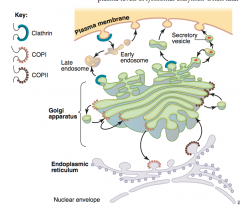
COP1: Golgi to Golgi (retrograde); Golgi to ER
COP2: Golgi to Golgi (anterograde); ER to Golgi
Clathrin: trans-Golgi to lysosomes; plasma membrane to endosomes (receptor-mediated endocytosis--i.e. LDL receptor activity)
|
|
|
What is the function of peroxisomes? |
membrane-enclosed organelle involved in catabolism of very-long chain fatty acids; branched chain fatty acids and, amino acids |
|
|
What is the function of proteasome? |
Barrel-shaped protein complex that degrades damaged or ubiquitin-tagged proteins.
Defects in ubiquitin-proteasome system have been implicated in some cases of Parkinson disease |
|
|
Describe the structure of microtubules. |

Cylindrical structure composed of a helical array of polymerized heterodimers of alpha and beta tubulin. Polymerization occurs slowly from positive end, but depolarization occurs rapidly without a GTP cap in place.
Each dimer has 2 GTP bound.
Incorporated into flagella, cilia and mitotic spindles.
Also involved in slow axoplasmic transport in neurons. |
|
|
Describe the molecular motor proteins involved in transporting cellular cargo toward opposite ends of microtubule tracks. |
transport various cellular cargo by walking on microtubules in their respective directions:
dynein = retrograde to microtubule (+ end to - end)
kinesin = anterograde to microtubule (- end to + end) |
|
|
Drugs that target microtubules: |
Microtubules Get Constructed Very Poorly
Mebendazole (anti-helminthic) Colchicine (anti-gout) Paclitaxel (anti-cancer) |
|
|
Describe the structure of cilia.
What is axonemal dynein? |
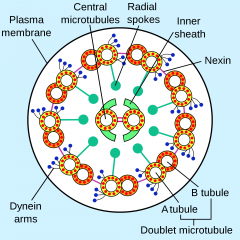
9 + 2 arrangement of microtubules.
Axonemal dyne in—an ATPase that links peripheral 9 doublets and causes bending of cilium by differential sliding of doublets.
|
|
|
Describe Kartagener syndrome and its clinical findings. |
immotile cilia due to a dynein arm defect.
Results in male and female infertility due to immotile sperm and dysfunctional fallopian tube cilia, respectively ↑ risk of ectopic pregnancy
Can cause bronchiectasis, recurrent sinusitis, and situs inversus (e.g., dextrocardia on CXR). |
|
|
Cytoskeletal element: Describe intermediate filaments |
Structure. Vimentin, desmin, cytokeratin, lamins, glial fibrillary acid proteins (GFAP), neurofilaments.
intermediate filaments are extremely stable. Even after extraction with solutions containing detergents and high concentrations of salts, most intermediate filaments in a cell remain intact, whereas microfilaments and microtubules depolymerize into their soluble subunits |
|
|
What is the composition of plasma membranes. |
Asymmetric lipid bilayer.
Contains cholesterol, phospholipids, sphingolipids, glycolipids, and proteins.
Fungal membranes contain ergosterol. |
|
|
List the immunohistochemical stains for intermediate filaments (stain and cell type): |
Vimentin -- Connective Tissue DesMin -- Muscle Cytokeratin -- Epithelial cells GFAP -- NeuroGlia Neurofilaments -- Neurons |
|
|
Describe the Sodium Potassium ATPase pump. |
Na+-K+ ATPase is located in the plasma membrane with ATP site on cytosolic side.
For each ATP consumed, 3 Na+ go out and 2 K+ come in. |
|
|
Describe the interaction of compounds with the Na/K pump and how it inhibits this pump's activity. |
Ouabain inhibits by binding to K+ site.
Cardiac glycosides (digoxin and digitoxin) directly inhibit the Na+-K+ ATPase (mainly in myocardium), which leads to indirect inhibition of Na+/ Ca2+ exchange. Without Ca being pumped out of cell, this increases intracellular Ca, which results in increase in cardiac contractility. |
|
|
What is collagen? |
Most abundant protein in the human body. Extensively modified by posttranslational modification. |
|
|
Describe the structure of collagen. |
consists of three polypeptide chains (alpha chains) wound around each other to form a long, stiff triple helical structure.
collagen is glycine and proline rich with glycine present at every third amino acid. GLY-X-Y = X & Y can be any amino acid, but X is commonly proline and Y is commonly hydroxyproline
different alpha chain compositions in the various types of collagen |
|
|
What does type 1, 2, 3, 4 and 10 collagen constitute in the body? |
Be (So Totally) Cool, Read Books.
type 1 = Most common (90%)—Bone (made by osteoblasts), Skin, Tendon, dentin, fascia, cornea, late wound repair.
type 2 = Cartilage (including hyaline), vitreous body, nucleus pulposus.
type 3 = Reticulin—skin, blood vessels, uterus, fetal tissue, granulation tissue.
type 4 = Basement membrane, basal lamina, lens.
type 10 = epiphyseal plate |
|
|
Describe the process of collagen being laid down during wound healing. |
Wound healing: Type 3 to Type 1 Three: owie (just scraped your knee) One: it's all done
Type 3 collagen is laid down first in granulation tissue. As healing progresses, fibroblasts secrete type 1 collagen, which eventually replaces type 3 collagen in late wound repair. |
|
|
Describe collagen synthesis "inside" the fibroblast. |
Nucleus: 1. Formation of alpha chains mRNA (preprocollagen) in nucleus. 2. Nuclear export of preprocollagen mRNA followed by entry into rough ER.
RER: 3. SYNTHESIS of preprocollagen alpha chains with registration sequence (responsible for quaternary structure) by ribosomes 4. HYDROXYLATION of proline and lysine catalyzed by peptidyl proline hydroxylase and peptidyl lysine hydroxylase, respectively. 5. GLYCOSYLATION of hydroxylysine residues 6. Formation of alpha chain triple helix = procollagen
Golgi: 7. addition of carbohydrates 8. packaging into vesicles and movement to plasma membrane for exocytosis of procollagen. |
|
|
Describe collagen synthesis "outside" the fibroblast. |
1. PROTEOLYTIC PROCESSING: Procollagen peptidase cleave registration sequences (disulfide-rich terminal regions) of procollagen to form insoluble tropocollagen 2. CROSS-LINKING: Reinforcement of many staggered tropocollagen molecules by covalent lysine-hydroxylysine cross-linkage (by Cu2+-containing lysyl oxidase) to make collagen fibrils |
|
|
Which aspect of collagen synthesis requires Vitamin C? |
hydroxylation of proline and lysine |
|
|
Describe the pathology of Scurvy. |
Vitamin C deficiency results in inability to hydroxylate proline and lysine resides in alpha chain polypeptides of collagen molecules
Causes weakening of capillaries: ulceration and bleeding gums loose teeth (due to loss of periodontal ligaments, which are collagen rich) tissue hemorrhage anemia poor wound healing impaired bone formation (during growth) |
|
|
Describe the genetics and cellular characteristics of Osteogenesis Imperfecta. |
most common form is autosomal dominant -- variety of gene defects cause deficiency in production of type 1 collagen --deficiency arises from an amino acid substitution of glycine to bulkier amino acids in the collagen triple helix structure
leads to either less collagen or less functional collagen = weak or brittle bones
|
|
|
Describe the clinical finding of Osteogenesis Imperfecta. |
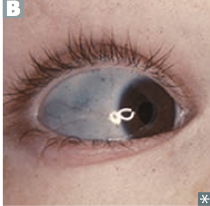
Multiple fractures with minimal trauma; may occur during the birth process; may be confused with child abuse Blue sclerae due to the translucency of the connective tissue over the choroidal veins Hearing loss (abnormal ossicles) Dental imperfections due to lack of dentin (defects in enamel synthesis = amelogenesis imperfecta) |
|
|
XRay in osteogenesis imperfecta. |

|
|
|
Although there are four types: Contrast Type 1 and Type 2 osteogenesis imperfecta. |
Type I * Most common and mildest type of OI.* Bones fracture easily. Most fractures occur before puberty. * Normal or near-normal stature. * Loose joints and muscle weakness. * Sclera (whites of the eyes) usually have a blue, purple, or gray tint. * Triangular face. * Tendency toward spinal curvature. * Bone deformity absent or minimal. * Brittle teeth possible. * Hearing loss possible, often beginning in early 20s or 30s. * Collagen structure is normal, but the amount is less than normal. * Most severe form. * Frequently lethal at or shortly after birth, often due to respiratory problems. * Numerous fractures and severe bone deformity. * Small stature with underdeveloped lungs. * Tinted sclera. * Collagen improperly formed. |
|
|
Describe the pathology of Ehlers-Danlos Syndrome. |
Faulty collagen synthesis causing hyperextensible skin, tendency to bleed (easy bruising), and hypermobile joints. 6+ types. Inheritance and severity vary. Can be autosomal dominant or recessive. May be associated with joint dislocation, berry and aortic aneurysms, organ rupture. |
|
|
Describe the hyper mobility type of Ehlers-Danlos syndrome. |
(joint instability): most common type.
usually least severe
|
|
|
Describe the classic type of Ehlers-Danlos syndrome. |
(joint and skin symptoms): characterized by skin hyperelasticity, joint hypermobility, increased tendency to bruise, and abnormal cigarette paper scarring. Mutations in type V collagen (a regulator of type I collagen fibrillogenesis). |
|
|
Describe the vascular type of Ehlers-Danlos syndrome. |
(vascular and organ rupture): deficient type III collagen ie. colon, large blood vessels and gravid uterus are rich in type 3 collagen |
|
|
Describe the pathology of Epidermolysis Bullosa. |
Absence of Type 7 collagen Type 7 collagen is responsible for formation of anchoring fibrils between dermis and epidermis (anchor basement membrane to underlying dermis)
This results in paper thin skin (called "butterfly children": because their skin is as delicate as butterfly wings) |
|
|
Describe the pathology of Menkes disease. |
Connective tissue disease caused by impaired copper absorption and transport.
Leads to decrease activity of lysyl oxidase (copper is a necessary cofactor) = decrease cross linking
Results in brittle, “kinky” hair, growth retardation and hypotonia. |
|
|
Define the term argyrophilic. |
silver loving:
reticular fibers (type 3 collagen molecules) are recognized by silver stain |
|
|
Describe the pathology of Goodpasture syndrome. |
antibodies against glomerular basement membrane as well as antibodies against basement membrane of lung tissue: bind to type 4 collagen
leads to glomerulonephritis and pulmonary hemorrhage |
|
|
Describe the pathology of Alport syndrome. |

Mutation in type IV collagen: thinning and splitting of the glomerular basement membrane. Most commonly X-linked.
Glomerulonephritis, deafness, and, less commonly, eye problems (cataracts/anterior lenticonus).
|
|
|
Elastic fibers consist of what two structural components?
As elastic fibers allow tissues to stretch and distend, give examples of where these fibers are located.
When elastin proteins are cross linked into elastic fiber network, their collective coil properties allow the network to be stretched and recoil like a rubber band. |
elastin and surrounding fibrillin microfibrils
vertebral ligaments (ligamentum flava; ligamentum nuchae) vocal folds of larynx elastic arteries skin lung |
|
|
Elastin is a highly hydrophobic protein that is rich in ____________________; elastin is poor in _________ and lacks ________________. |
rich in glycine and proline (like collagen)
poor in hydroxyproline
lacks hydroxylysine |
|
|
Elastin is normally broken down by ___________, which is normally inhibited by _______________. |
elastase
alpha-1-antitrypsin |
|
|
Elastin synthesis parallels collagen synthesis within fibroblasts and Smooth muscle cells. What are the two main steps of elastin synthesis? |
1. secretion of tropoelastin (elastin precursor)
2. cross-linking of tropoelastin molecules via their two unique amino acids (desmosine and isodesmosine) to form extensive networks of elastin fibers and sheets (also requires lysyl oxidase for cross-linking) |
|
|
Describe Fibrillin-I glycoprotein. |
a major component of the microfibrils that form a sheath surrounding the amorphous elastin (provides a scaffold for deposits of elastin molecules). It is believed that the microfibrils are composed of end-to-end polymers of fibrillin. |
|
|
Describe the mechanism of lysyl oxidase . |
An extracellular copper enzyme that catalyzes formation of aldehydes from lysine residues (called allysine) in collagen and elastin precursors.
These aldehydes are highly reactive, and undergo spontaneous chemical reactions with other lysyl oxidase-derived aldehyde residues, or with unmodified lysine residues. This results in cross-linking collagen and elastin, which is essential for stabilization of collagen fibrils and for the integrity and elasticity of mature elastin |
|
|
Give an example of how a copper deficiency would affect biologic structures. |
dissecting aneurisms of blood vessels due to incomplete elastin cross-linking |
|
|
Describe the genetic and cellular characteristics of Marfan Syndrome. |
autosomal dominant Gene: fibrillin gene (FBN1)
elastin-associated fibrillin microfibrils are absent; results in formation of abnormal elastic tissue |
|
|
Describe the clinical features of Marfan Syndrome |
Bone elongation (tall individuals with long, thin limbs) Spider-like fingers (arachnodactyly) Hypermobile joints Lens dislocation (glaucoma and retinal detachment also common) Cardiac abnormalities (mitral valve prolapse is common) Aortic rupture--most common cause of death (due to loss of elastic fibers in tunica media) |
|
|
What is the pathologic relationship of emphysema and elastin. |
can be caused by α1-antitrypsin deficiency, resulting in excess elastase activity |
|
|
What are wrinkles caused by? |
Wrinkles of aging are due to decrease in collagen and elastin production |
|
|
Glycosaminoglycans (GAGs) are long polysaccharide chains composed of repeating disaccharide units. Describe what these repeating units consist of. |
One of the disaccharide units is always an amino sugar (N-acetylglucosamine or N-acetylgalactosamine)
The second sugar is usually an uronic acid (glucuronic acid or iduronic acid) |
|
|
Why are GAGs the most negatively charged molecules produced by animal cells?
What is the purpose of their negative charge? |
sulfate and carboxyl groups present on most of their sugars
These highly negatively charged molecules are essential for maintaining the water content present in ground substance. |
|
|
5 Types of GAGs found in human body: Describe hyaluronic acid. |
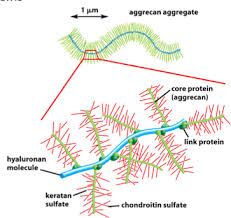
unsulfated
provide attachment sites of core proteins to form proteoglycan aggregates |
|
|
5 Types of GAGs found in human body: Location of Chondroitin sulfate |
cartilage, bone, heart valves |
|
|
5 Types of GAGs found in human body: Location of Keratin sulfate. |
cartilage, bone, cornea, intervertebral disk |
|
|
5 Types of GAGs found in human body: Location of DermatAn sulfate |
dermis of skin, blood vessels, heart valves |
|
|
5 Types of GAGs found in human body: Location of HeparAn sulfate |
basal lamina, lung and liver |

